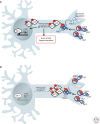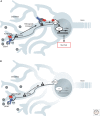Neuronal signaling through endocytosis
- PMID: 24492712
- PMCID: PMC3941234
- DOI: 10.1101/cshperspect.a020669
Neuronal signaling through endocytosis
Abstract
The distinctive morphology of neurons, with complex dendritic arbors and extensive axons, presents spatial challenges for intracellular signal transduction. The endosomal system provides mechanisms that enable signaling molecules initiated by extracellular cues to be trafficked throughout the expanse of the neuron, allowing intracellular signals to be sustained over long distances. Therefore endosomes are critical for many aspects of neuronal signaling that regulate cell survival, axonal growth and guidance, dendritic branching, and cell migration. An intriguing characteristic of neuronal signal transduction is that endosomal trafficking enables physiological responses that vary based on the subcellular location of signal initiation. In this review, we will discuss the specialized mechanisms and the functional significance of endosomal signaling in neurons, both during normal development and in disease.
Figures




References
-
- Altar CA, Cai N, Bliven T, Juhasz M, Conner JM, Acheson AL, Lindsay RM, Wiegand SJ 1997. Anterograde transport of brain-derived neurotrophic factor and its role in the brain. Nature 389: 856–860 - PubMed
-
- Arevalo JC, Waite J, Rajagopal R, Beyna M, Chen ZY, Lee FS, Chao MV 2006. Cell survival through Trk neurotrophin receptors is differentially regulated by ubiquitination. Neuron 50: 549–559 - PubMed
Publication types
MeSH terms
Substances
Grants and funding
LinkOut - more resources
Full Text Sources
Other Literature Sources
